1. Do you think the desiccation of the Sahara could have pushed Africans farther then the Nile valley into the Arabian peninsula?
2. How accurate would you say this map is?
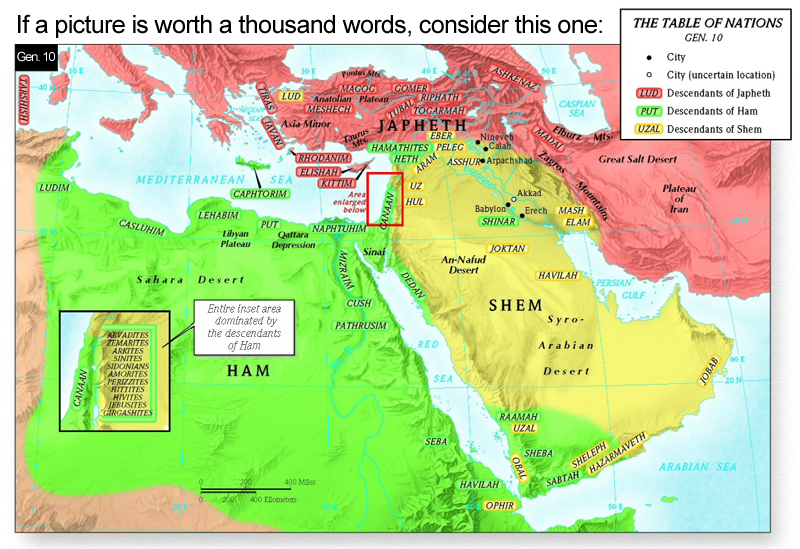

**Yes they are contradictory**
Context:
I've been moving away from the two terms Black and African. Not that there is anything necessarily wrong with them it's just that they tend to fall apart under close scrutiny. To be more precise, when used as delineators for sorting & grouping people the results tends to not be representative of what the terms Black and African Denote. The sorted group tends to fall under the connotation of those words which differ given different people, cultures, and politics. As a result and for the time being...
When I say "Black people" I'm referring to a subset(undecided) of humanity that is tropically adapted(which is my delineator) independent of any genetic make up or place of birth/residence.
When I say "African people" I'm referring to a subset of humanity that dwelled in and migrated out of the current day Sahara-Sahale region during it's green phase and subsequent Desertification. This includes the people they absorbed in the process of spreading across the continent & world. This is independent of birth place, politics, religion, culture, phenotype, or nationality.(because they are not the delineator) This is generally typified by the genetic presence of paternal PN2 and maternal L1, L2, L3
**These are not hard fast definitions it's simply were I'm at right now**
As always when thinking about cultural groups I start by mentally moving through the movements of people until I get to the period under question then I stop and review what I have before me. The difference is that now I'm going to start doing it in the open instead of mentally.**I need to make a gif for this purpose**
Prior to ejection from the Sahara:
Africans have been in the sahale-Saharan area since at least around the aqualithic /green Saharan period.
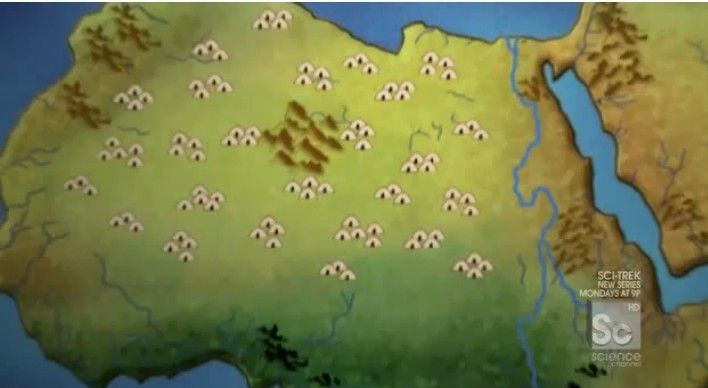
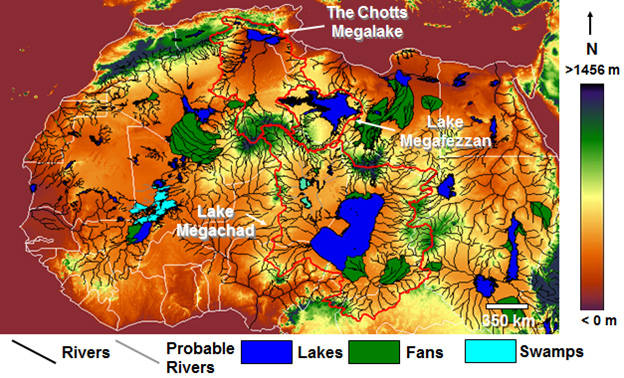
The occupation of the Sahara was one that shared certain material culture commonalities throughout such as barbed harpoons for fishing and wavy lined pottery for storage.


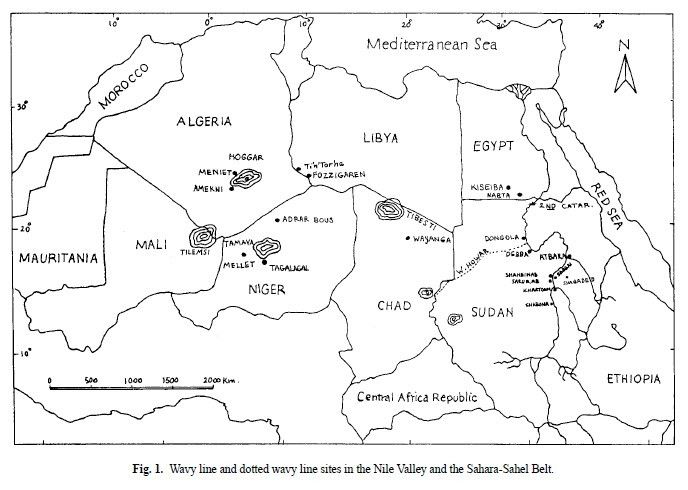
Ejection from the Sahara: Southward
As the Sahara began to dry out the people began to be pushed out of and mashed between, the desert and forest belt in what is now called the Sahale, gathering primarily around lake chad creating and extending across the ancient sahale to Nile trade routs.

Trailing the river routs down into Cameroon and Nigeria were they would set the staging grounds for the later bantu migration to occur as the area becomes overpopulated from reproduction and further dessication in the north pushes more people south.

Ejection from the Sahara: Westward
To the west they were pushed to the Niger bend and Southern Mauritania resulting in early population centers around Tichitt-Walata.
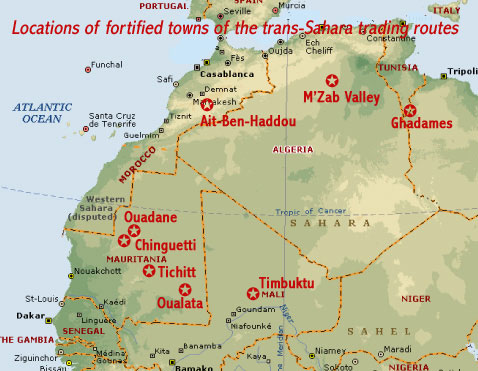





Tichitt-Walata and the Middle Niger: evidence for cultural contact in the second millennium BC **Further reading**
http://www.yumpu.com/en/document/view/1 ... iation-of-
Ejection from the Sahara: Eastward
To the east they gathered around the Nile valley

"The evidence also points to linkages to
other northeast African peoples, not
coincidentally approximating the modern
range of languages closely related to
Egyptian in the Afro-Asiatic group
(formerly called Hamito-Semetic). These
linguistic similarities place ancient
Egyptian in a close relationship with
languages spoken today as far west as
Chad, and as far south as Somalia.
Archaeological evidence also strongly
supports an African origin. A widespread
northeastern African cultural assemblage,
including distinctive multiple barbed
harpoons and pottery decorated with
dotted wavy line patterns, appears during
the early Neolithic (also known as the
Aqualithic, a reference to the mild
climate of the Sahara at this time).
Saharan and Sudanese rock art from this
time resembles early Egyptian
iconography. Strong connections
between Nubian (Sudanese) and
Egyptian material culture continue in
later Neolithic Badarian culture of Upper
Egypt. Similarities include black-topped
wares, vessels with characteristic
ripple-burnished surfaces, a special
tulip-shaped vessel with incised and
white-filled decoration, palettes, and
harpoons...
Other ancient Egyptian practices show
strong similarities to modern African
cultures including divine kingship, the
use of headrests, body art, circumcision,
and male coming-of-age rituals, all
suggesting an African substratum or
foundation for Egyptian civilization..
Source: Donald Redford (2001) The
Oxford encyclopedia of ancient Egypt,
Volume 3. Oxford University Press. p.
28
Resulting in the moving of people from the south founding the Nile valley civilizations of Kerma/kush and kemet(ancient egypt)




Early settlement
Human populations settled in the Kerma Basin at a very early date, as evidenced by several Mesolithic and Neolithic sites. The earliest traces of a human presence in the region date back tens of thousands of years. From 7500 BC onward the archaeological remains become more significant: semi-buried dwellings, various objects and tools, and graves.[5] What’s clear is that Kerma’s civilisation emerged out of an ancient pastoral culture that had flourished in that part of Sudan since at least 7000 B.C. when the first settlements were established. Near Kerma, archaeologists have discovered one of the two oldest cemeteries ever found in Africa – dating back to 7500 B.C. – and the oldest evidence of cattle domestication ever found in Sudan or, indeed, in the Egyptian Nile Valley. Around 3000 B.C., a town began to develop near the Neolithic dwellings.
Pre-Kerma (c. 3500-2500BC) No C-Group Phase
Early Kerma (c. 2500-2050BC) C-Group Phase Ia-Ib
Middle Kerma (c. 2050-1750BC) C-Group Phase Ib-IIa
Classic Kerma (c. 1750-1580BC) C-Group Phase IIb-III
Final Kerma (c. 1580-1500BC) C-Group Phase IIb-III
Late Kerma – ‘New Kingdom’ (c.1500-1100?BC) ‘New Kingdom’
The Eco-Political Structure of Kerma
Until recently, the Kerma civilisation was known only from the townsite and cemeteries of its metropolitan centre and smaller sites to the north, towards Egypt. However, recent survey and excavation work has identified many new sites south of Kerma, many located on channels of the Nile, now dry, which lay to the east of the modern course of the river. This pattern of settlement indicates a substantial population and for the first time provides us with some sort of context in which we can place Kerma itself. Survey work in advance of the Merowe Dam at the Fourth Cataract has confirmed the presence of Kerma sites at least as far upriver as the Abu Hamed/Mograt Island area.[1]
Kerma was evidently a sizable political entity - Egyptian records speak of its rich and populous agricultural regions. Unlike Egypt, Kerma seems to have been highly centralized. It controlled the 1st to 4th Cataracts, which meant its domain was as extensive as ancient Egypt.[2]
Numerous village communities scattered alongside fields of crops made up the bulk of the realm, but there also seems to have been districts wherein pastoralism (goat, sheep and cattle) and gold processing were important industries.[3] Certain Kerma towns served to centralize agricultural products and direct trade. Analysis of the skulls of thousands of cattle interred in royal Kerma tombs suggest that stock were sometimes brought vast distances, from far districts, presumably as a type of tribute from rural communities on the death of Kerma's monarchs. This parallels the importance of cattle as 'royal property' in other parts of Africa at later times.
Only the centres of Kerma and Sai seem to have had contained sizable urban populations. Possibly further excavations will reveal other regional centres. At Kerma and Sai, there is much evidence of wealthy elites, and a class of dignitaries who monitored trade in merchandise arriving from far-off lands, and who supervised shipments dispatched from administrative buildings. Evidently Kerma played an important 'middle man' role in the trade of luxury items from the African interior to Egypt [4]


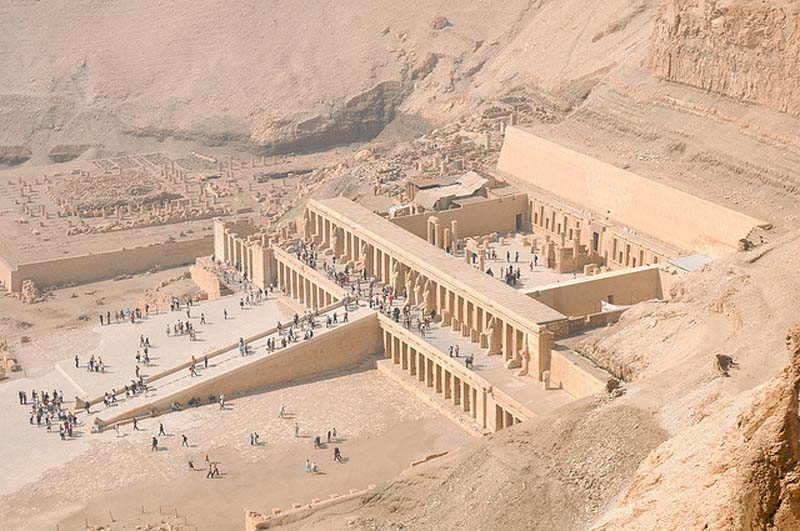
Ejection from the Sahara: Northward
Subsequently moving into north Africa at a much later date 1000 BC - 100 AD
ABSTRACT
The Berber languages are relatively well-studied, and it is possible to explore their geographical extent today and in the past, and also reconstruct basic and culturalvocabulary which can be attributed to speakers of proto-Berber. However, there is a major problem reconciling this with textual and archaeological evidence. The proto-Berber we can reconstruct seems to be far to recent to match what we know from other evidence; indeed it seems to reach back to period as late as 200 AD. Textual evidence (and Canarian inscriptions) point to a period prior to 400 BC, while the most credible archaeological correlate would be the spread of pastoralism across the Sahara, pointing to the period 5-4000 BP. The paper explores this disjunction and suggests the underlying reason for it is massive language levelling in the period after 0 AD. In other words, the original speakers of Berber did indeed spread out westwards from the Nile Valley, 5-4000 years ago, but the diversity which evolved in this period was eliminated by a sociolinguistic processes which levelled divergent speech forms. Historical linguists have been wary of invoking such process until recently, but evidence is mounting for their importance in many and varied cultures, including China, Borneo and Madagascar. Hypotheses are evaluated to explain the Berber situation and it is suggested that a combination of the introduction of the camel and the establishment of the Roman limes were the key factors in creating this linguistic bottleneck.
-Recent work by Roger Blench.
http://www.rogerblench.info/Archaeology ... 202012.pdf
************
Ejection from the Sahara: Into Arabian peninsula
But again how far would you say the Saharan population was pushed given the info at your disposal?


“From a genetic point of view, several
recent genetic studies have shown that
subSaharan genetic lineages (affiliated
with the Y-chromosome PN2 clade;
Underhill et al. 2001) have spread
through Egypt into the Near East, the
Mediterranean area, and, for some
lineages, as far north as Turkey
(E3b-M35 Y lineage; Cinniogclu et al.
2004; Luis et al. 2004), probably during
several dispersal episodes since the
Mesolithic (Cinniogelu et al. 2004; King
et al. 2008; Lucotte and Mercier 2003;
Luis et al. 2004; Quintana-Murci et al.
1999; Semino et al. 2004; Underhill et al.
2001).
This finding is in agreement with
morphological data that suggest that
populations with sub-Saharan
morphological elements were present in
northeastern Africa, from the Paleolithic
to at least the early Holocene, and
diffused northward to the Levant and
Anatolia beginning in the Mesolithic.
Indeed, the rare and incomplete
Paleolithic to early Neolithic skeletal
specimens found in Egypt - such as the
33,000-year-old Nazlet Khater specimen
(Pinhasi and Semai 2000), the Wadi
Kubbaniya skeleton from the late
Paleolithic site in the upper Nile valley
(Wendorf et al. 1986), the Qarunian
(Faiyum) early Neolithic crania
(Henneberg et al. 1989; Midant-Reynes
2000), and the Nabta specimen from the
Neolithic Nabta Playa site in the western
desert of Egypt (Henneberg et al. 1980) -
show, with regard to the great African
biological diversity, similarities with
some of the sub-Saharan middle
Paleolithic and modern sub-Saharan
specimens. This affinity pattern
between ancient Egyptians and
sub-Saharans has also been noticed by
several other investigators..”
--Ricaut and Walekens (2008) ‘Cranial
Discrete traits)








